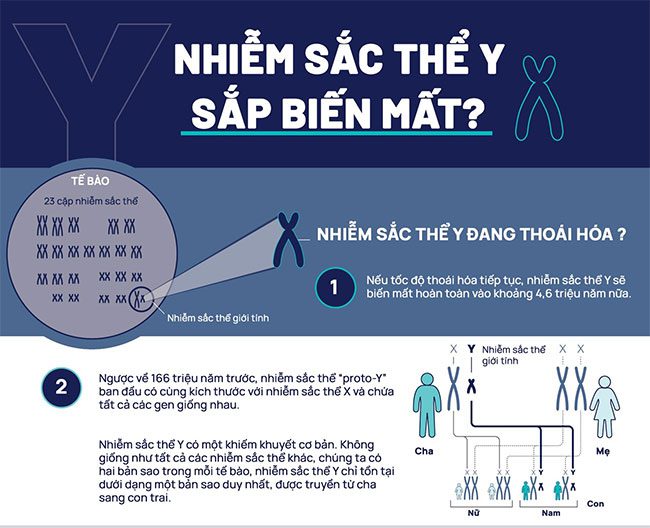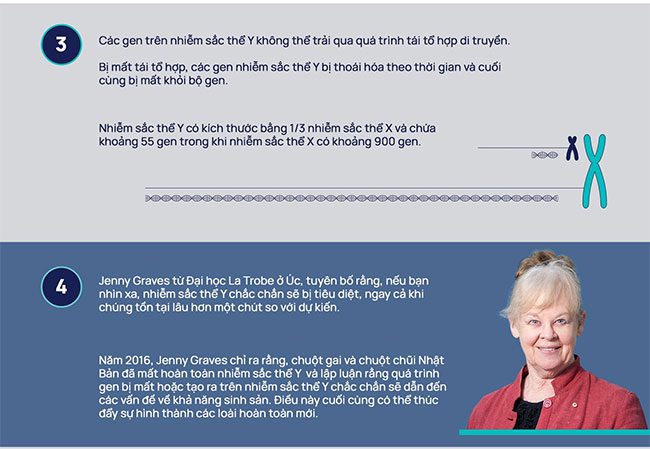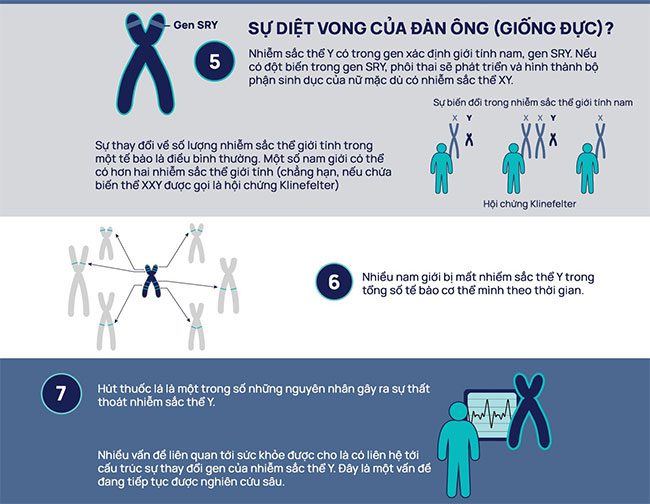The Y chromosome is a symbol of masculinity, but it is increasingly showing signs of weakness and rapid degeneration. While women with two X chromosomes are completely normal, men with one X and one Y chromosome are gradually experiencing shrinkage.



Is the Y chromosome degenerating?
If the pace of degeneration continues, the Y chromosome will completely disappear in about 4.6 million years. This period may seem long, but compared to the existence of life on Earth for 3.5 billion years, it is not long at all.
Going back 166 million years, the story was completely different. The original “proto-Y” chromosome was the same size as the X chromosome and contained all the same genes. However, the Y chromosome has a fundamental flaw. Unlike all other chromosomes, where we have two copies in each cell, the Y chromosome exists only as a single copy, passed down from father to son.
This means that the genes on the Y chromosome cannot undergo the process of genetic recombination, the “shuffling” of genes that occurs in each generation to eliminate harmful gene mutations. Without the benefits of recombination, the Y chromosome genes degenerate over time and eventually disappear from the genome.
However, recent research has demonstrated that the Y chromosome has developed some quite convincing mechanisms to “brake”, slowing the rate of gene loss to a point where it may stop completely.
A recent study from Denmark, published in PLoS Genetics, sequenced portions of the Y chromosome from 62 different men and found that it tends to rearrange in large-scale structures allowing for “gene amplification” – producing multiple copies of genes that enhance health, sperm function, and minimize gene loss.
The study also indicated that the Y chromosome has developed unusual structures known as “palindromes” (DNA sequences that read the same forward and backward, like the word “kayak”), which help protect it from further degeneration. They recorded a high rate of “gene conversion events” in the palindromic sequences on the Y chromosome – essentially a “copy and paste” process that allows for repairing damaged genes using an undamaged backup copy as a template.
Looking at other species (the Y chromosome exists in mammals and some other species), there is increasing evidence suggesting that Y chromosome gene amplification is a widespread principle. These amplified genes play a crucial role in sperm production and (at least in rodents) in regulating the sex ratio of offspring. Researchers provide evidence that the increase in gene copy number in mice is a result of natural selection.
Regarding the question of whether the Y chromosome will actually disappear, there is a divide in the global scientific community and among UK scientists.
One group argues that its protective mechanisms are working very well and have saved the Y chromosome. But another group disputes this. The debates continue.
Jenny Graves from La Trobe University in Australia claims that, looking far ahead, the Y chromosome will undoubtedly be eradicated, even if it exists a bit longer than expected. In a 2016 paper, Jenny Graves noted that the spiny mouse and the Japanese mole have completely lost their Y chromosome and argued that the process of gene loss or creation on the Y chromosome will certainly lead to reproductive issues. This could ultimately drive the formation of entirely new species.
The extinction of men?
There are arguments that even if the Y chromosome in humans disappears, it does not mean that men themselves are about to vanish. Even in species that have completely lost the Y chromosome, both males and females are still necessary for reproduction.
In these cases, the “master switch” gene SRY that determines male sex has moved to another chromosome, meaning these species can produce males without a Y chromosome. However, the new sex-determining chromosome – the chromosome that SRY has transferred to – will then begin the degeneration process due to the lack of recombination just like their previous Y chromosome.
Interestingly, in humans, while the Y chromosome is necessary for normal human reproduction, many of the genes it carries are not essential if assisted reproductive techniques are employed. This means that genetic techniques may soon replace the gene functions of the Y chromosome, allowing same-sex couples or infertile men to conceive. However, even if everyone could conceive this way, it seems unlikely that fertile individuals would stop reproducing naturally.
We do not know whether the Y chromosome will disappear or not, and even if it does, it is likely that we will still need men for normal reproduction.
Indeed, the prospect of a “factory farm” system where a few “lucky” men are selected to father the majority of our offspring certainly does not seem to be the case. In any event, there will be many more pressing concerns in the next 4.6 million years.
Some facts about chromosomes
Many health issues are believed to be related to changes in the structure of the Y chromosome. This is an area that continues to be deeply researched.
Changes in the number of sex chromosomes in a cell are normal. Some men may have more than two sex chromosomes (for example, if they have the XXY variant known as Klinefelter syndrome), and many men lose the Y chromosome in their body cells over time. Smoking is one of the causes of Y chromosome loss.
The Y chromosome contains the gene that determines male sex, the SRY gene. If there is a mutation in the SRY gene, the embryo will develop and form female genitalia despite having XY chromosomes.



















































